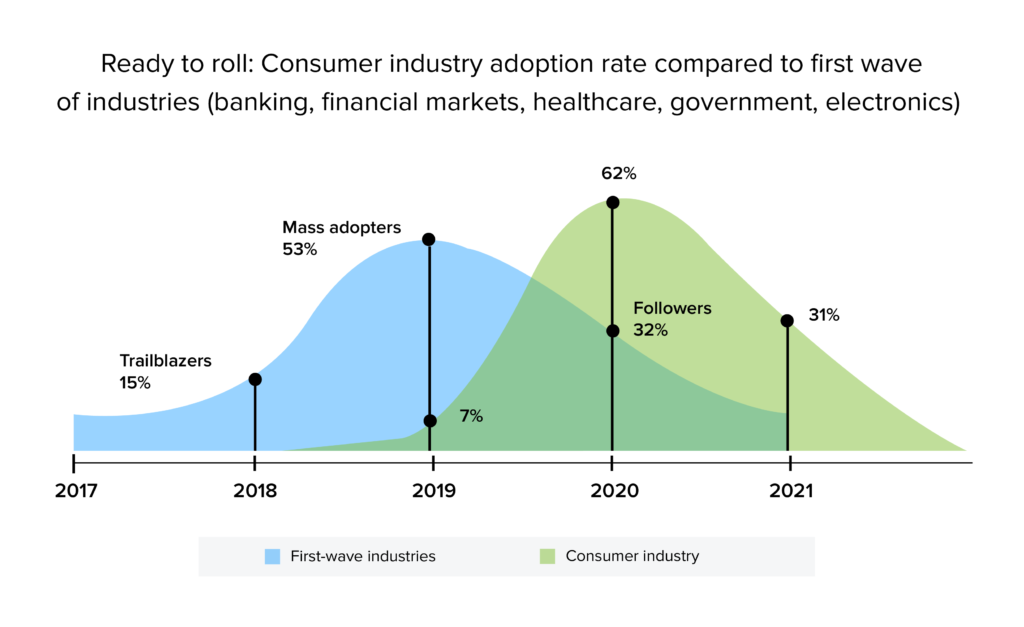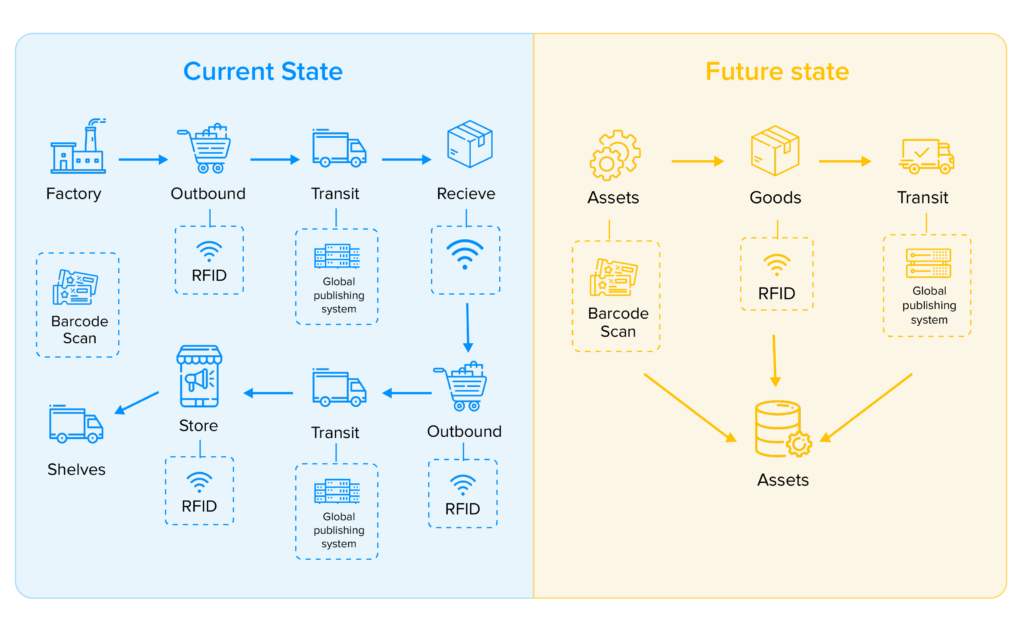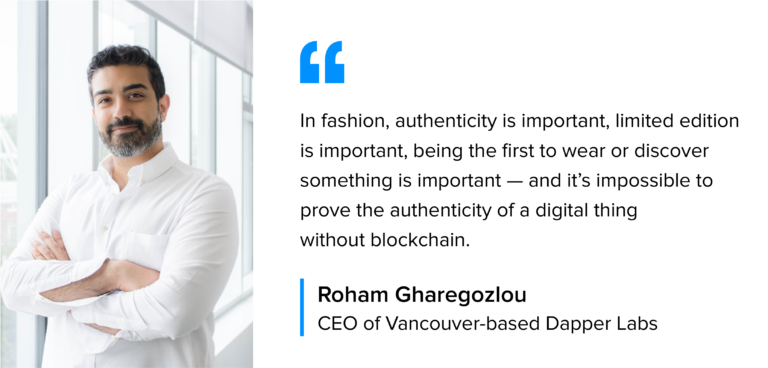How Blockchain Technology is Transforming the Fashion Industry?
The breach-proof record-keeping technology is being used for bringing transparency in the fashion industry supply chains, tracking the welfare of factory workers, and transferring the ownership of digital fashion, among a plethora of other areas which are the industry’s constant irrespective of what is in trend.
Blockchain, like the apparel industry, has evolved massively ever since it was ideated. Introduced in the fashion world for the first time in the Shanghai Fashion Week 2016, the technology has today expanded its use cases in the direction of making the sector highly efficient and transparent.
Let’s dive deep into the details of what the combination of Blockchain and fashion can lead to.

Here are a Few Ways in Which Blockchain Clothing is Reshaping the Fashion Industry
Solves issues surrounding counterfeiting
According to the Global Brand Counterfeiting Report 2018, the estimates of offline and online counterfeiting of textiles, cosmetics, clothing, and footwear have reached a $98 Billion mark.
Blockchain, by being spread throughout the supply chain, helps customers obtain information about the product origin and the journey it has taken through the help of an embedded chip. This helps the customers with the necessary information required to reject counterfeit products or the ones that come from ethically questionable production units.
The concept was first tested by Martine Jarlgaard in 2017 who produced the first garments having smart labels on Blockchain. Every step of the manufacturing process was recorded in the label for the owners and the brands to authenticate.
Supports sustainability practices
The potential of Blockchain in fashion retail comes with the capability to track physical or digital products throughout the lifecycle. This transparency in the supply chain tracking process offers producers insights into their value chain, giving them the guarantee of a proper third-party goods handoff and final product labeling.
Blockchain development companies, by tracking the assets’ progression, come with the potential to expand ethical and sustainable creation and consumption of a commodity on a global scale.
Improves efficiency in the apparel industry

At present, the number of stakeholders involved in a production and distribution line = the number of individual records. Blockchain in fashion industry, however, brings the entire supply chain on a centralized digital platform. This saves the weeks it would take to identify the material origin and supply line.
Another benefit that is highlighted in bold in every Blockchain for entrepreneur guide is how nobody can lose, alter or, destroy a record once it has been added in the Blockchain.
Convenient royalty tracking
Blockchain technology makes it convenient to track royalty payments. It doesn’t just allow the designers to develop an unchangeable proof of creation but it can also be used for creating and tracking trademarks, license designs in addition to royalty programs or sales originating through these designs.
The convenience is what makes Blockchain not just a key part of the changing fashion industry but also a prime technology and trends of the media and entertainment industry.
Reduction of operating costs
By the three-fold benefits of better data management, transforming supply chain, and lowered risk of counterfeiting, Blockchain technology offers a way to lower down the operational costs. It provides an easy to integrate surface for data reconciliation across the operations and service lines.
Transfer the ownership of digital clothing
Digital clothing is becoming increasingly popular. Designers are giving their customers the option to buy digital garments with the option to be digitally fitted in it. A trend initiated by CryptoKitties, the procurement of digital goods have today become one of the key interest areas of making money from Dapps.
The ownership of the digital garment gets transferred through Blockchain technology, which in turn makes it impossible to counterfeit the design. “Blockchain allows us to create digital one-offs,” says Kerry Murphy, the founder of The Fabricant. “It’s a way to create uniqueness and desirability.”
What is the Promise of Blockchain to the Fashion Industry?
Think of the ease of tracking a garment right to the material for which it was made from, its purchase history on a website or, in-store. Imagine scanning a tag on a jacket or shirt and reading its origin story. Imagine a time where traceability and transparency are designed in apparel production and distribution, sustainability can be proven, and the customers can choose what to buy with the utmost confidence.
Turning these imaginations into reality is Blockchain’s promise.

Moving further, let’s look into the companies that are using Blockchain in apparel industry.
Companies Setting the Blockchain in Fashion Trend
Here are a few fashion brands using blockchain technology:
- Arianee protocol was developed as a product certification and communication mode between the owner and the brand behind an item. Every piece receives a Blockchain-based certificate which enables the consumers to keep track of the authenticity of the product.
- LVMH partnered with ConsenSys and Microsoft for launching a Blockchain-based platform known as Aura. The goal behind it is to ensure the authenticity and traceability of luxury products. It offers lifecycle tracking, proof of origin, protection of intellectual property, etc.
- Hugo Boss is also exploring Blockchain-based use cases for tracking their goods in the supply chain which would show the ownership and its transfer among the peers in a network, transparently.
Getting Practical: How to Get Started with Blockchain in Apparel Industry
We recently worked with a fashion brand struggling to prove their worker welfare to the industry. They were also looking to authenticate the origin of their resell luxury items. While this is one project, these are some of the most common challenges in the fashion industry that the sector faces and seeks Blockchain development solutions for.
In case you too are facing challenges in the fashion industry and looking to combine fashion and Blockchain to make the domain more efficient, we would advise you to talk to your Blockchain development firm about designing a product that would gather information from the right people. If you wish to invest in a Blockchain app development process that lets you show details of the fabric, the raw material, or the chemicals used, ask the developers to create a structure of the information on how they will be making it accessible.
Once you have identified your goals and needs, the next thing would be to decide the level of trust you want to operate in. While Bitcoin has popularized the concept of a trustless system, it is not the only possibility when you sit and plan the consensus algorithms. Next would be selecting a Blockchain platform. There are multiple platforms each having their unique characteristics. Once you are through with this, the stage would come to work on the app frontend and UI ensuring that it is easy to be used among a range of stakeholders.
Parting Words
Blockchain apparel technology, at the back of its trustless operating system, enables the customers to look at and understand the complexity that it takes to bring a product to the market. This does not just help with changing their perception of value but also lowers the massive quantity of products thrown out within a year of usage.
When incorporated rightly by Blockchain app developers, it can help the fashion industry not just validate their intention to focus on sustainability and quality but also maintain the margins and revenues to keep them afloat, no matter how drastically the fashion trend changes. In case you still have any questions, contact the best blockchain development company USA. This will aid you to become a leader in the Blockchain-powered, digitally transformed supply chain ecosystem.

strategies your digital product..




